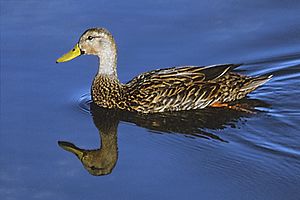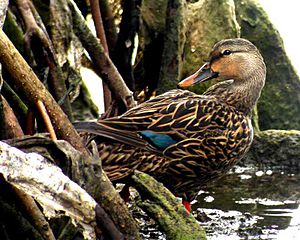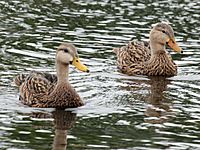Mottled duck facts for kids
Quick facts for kids Mottled duck |
|
|---|---|
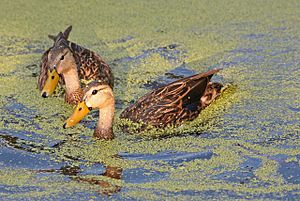 |
|
| Conservation status | |
| Scientific classification | |
| Genus: |
Anas
|
| Species: |
fulvigula
|
| Subspecies | |
|
|
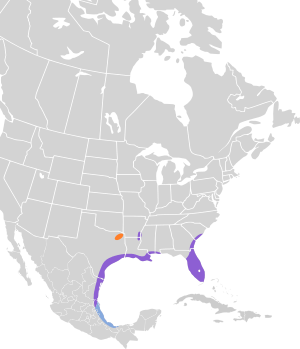 |
|
The mottled duck (Anas fulvigula) is a medium-sized duck that finds its food by "dabbling." This means it tips its body forward to reach food in shallow water, rather than diving completely underwater.
This duck looks a bit like a female mallard and the American black duck. It is closely related to these two duck species.
There are two main types, or subspecies, of the mottled duck. One type, called the Gulf Coast mottled duck (A. f. maculosa), lives along the Gulf of Mexico coast. You can find it from Alabama all the way to Tamaulipas in Mexico. Sometimes, these ducks travel a bit further south to Veracruz.
The other type is the Florida mottled duck (A. f. fulvigula). This duck lives in central and southern Florida. Occasionally, it might fly north into Georgia.
In the 1970s and 1980s, some mottled ducks were brought to South Carolina. These ducks, which are a mix of both types, have now spread out. They live along the Atlantic coast from Georgia into northeastern Florida.
Along the Gulf of Mexico coast, the mottled duck is one of the most common ducks to be banded. Banding helps scientists track birds. These ducks usually do not migrate far. About one out of every 20 mottled ducks has a band. This makes them a special find for hunters.
Contents
About the Mottled Duck
Adult mottled ducks are about 44 to 61 centimeters (17 to 24 inches) long. They have a dark body with a lighter head and neck. Their legs are orange, and their eyes are dark.
Both male and female mottled ducks have a shiny green-blue patch on their wings. This patch is called a speculum. Unlike the mallard, this patch does not have a white border.
You can tell male and female mottled ducks apart by their bills. Males have a bright yellow bill. Females have a deep to pale orange bill, which sometimes has black spots around the edges or near the base.
Mottled ducks are darker than female mallards, especially on their tails. Their bills are also more yellow. When they fly, the missing white border on their wing patch is a key way to identify them. The American black duck is usually darker than most mottled ducks. Its wing patch is more purple than blue. Mottled ducks act and sound similar to mallards.
What Mottled Ducks Eat
Mottled ducks find their food by dabbling in shallow water. They also graze on land, eating plants. They mostly eat plants, but they also enjoy some small water creatures like mollusks and aquatic insects.
These ducks are quite common in the areas where they live. They stay in the same place all year and do not migrate to other regions. They build their nests in coastal marshes. The nest is made on the ground among plants like bull-rush and marsh grass.
Mottled Duck Sizes
Here are some typical measurements for mottled ducks:
- Male:
- Length: 50 to 57.2 centimeters (19.7 to 22.5 inches)
- Weight: 876 to 1241 grams (30.9 to 43.8 ounces)
- Wingspan: 83.1 to 87.2 centimeters (32.7 to 34.3 inches)
- Female:
- Length: 46.9 to 53.4 centimeters (18.5 to 21.0 inches)
- Weight: 699 to 1151 grams (24.7 to 40.6 ounces)
- Wingspan: 80 to 83.1 centimeters (31.5 to 32.7 inches)
Different Types of Mottled Ducks
The mottled ducks living in Florida, mostly south of Tampa, are a specific type called Anas fulvigula fulvigula. They are sometimes called the Florida mottled duck.
This Florida type looks a bit different from the Gulf Coast mottled duck (A. f. maculosa). The Florida mottled duck is usually lighter in color and has fewer markings. Both types look like a mix between female mallards and American black ducks. However, the Florida mottled duck is more like a mallard, and the Gulf Coast mottled duck is more like an American black duck. You can often see this in the Gulf Coast type, where its lighter head stands out more clearly from its darker chest.
Since these two types of mottled ducks live in different areas, you usually only need to worry about confusing them with female mallards or American black ducks. Female American black ducks can be hard to tell apart from mottled ducks in the wild, except for their dark purple wing patch.
Scientists have studied the DNA of these ducks. They found that mottled ducks are more closely related to American black ducks than to mallards. Also, because they don't move around much, the two types of mottled ducks (Florida and Gulf Coast) are already quite different genetically.
Mottled Ducks and Other Ducks
Like other ducks in the "mallardine" group, mottled ducks can have fertile babies with their close relatives, like the American black duck and the mallard. This has always happened a little bit. Sometimes, American black ducks that fly south for winter might stay in the mottled duck's area and mate with them. The same can happen with mallards, which came to North America later.
Scientists have developed ways to identify these mixed-breed ducks. This helps them keep an eye on how much mixing is happening between Florida mottled ducks and mallards.
Even though some mixing happens, it's not a big problem right now. However, if their habitat is destroyed or if too many are hunted, this species could become rare. Then, the mixing with mallards could threaten to make them disappear as a unique type of duck.
This is especially true for the Florida mottled duck. Their living areas have shrunk a lot in recent years because of urbanization (more cities) and the draining of wetlands. This, along with climate change affecting the Everglades, could cause the Florida mottled duck population to drop. If that happens, hunting might need to be limited or stopped.
Currently, these birds seem to be doing okay, with about 50,000 to 70,000 individuals. While mixing with other ducks is common, just seeing double white bars on their wings is not enough to say they are mixed-breed ducks.
Gallery
See also
 In Spanish: Pato moteado para niños
In Spanish: Pato moteado para niños



